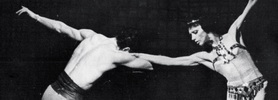“I Became a Ballerina through My Mother’s Prayers”
“I always say that it was pure chance that I became a ballerina. Fear of going on stage has pursued me all my life: not just nerves, but real fear. I even have a poor memory of the ballets in which I danced. After a performance, I could never remember what I had done onstage. My nervous system prevailed over absolutely everything. It is a miracle that I ever became a ballerina. It was probably through the prayers of my mother, because in her day she had been sent to ballet school, and you had to get all 11 ballerinas’ votes; you had to go and see all the ballerinas and show them what you could do. Anyway, she was one vote short and she was not accepted.
“I heard, ‘Oh, how capable she is! She will be this and that’, and I thought ‘What have I got? I don’t have anything like that’. I couldn’t see anything in myself, but there must have been something there. Chabukiani picked me out when I was still at school, and Sergeyev immediately gave me the role of the Lilac Fairy. They took a chance on me, and it was only in those ballets that I danced decently. Swan Lake, La Bayadère, and Raymonda just passed by. It is a myth that I danced well in them. Maybe I danced reasonably well in Raymonda. I reckon I was worse in La Bayadère, but when ‘The Kingdom of the Shades’ was taken abroad, I alternated with Dudinskaya and Zubkovskaya in the ballet.
“By the time I finished school I had put on a lot of weight, and I had great difficulty getting down to 54 kg at a height of 163 cm; by the end of my career I weighed 45 kg, and at that time that was considered to be the right weight. But initially they said that nothing would become of Osipenko, that she was getting fat and probably ate a lot. In fact, I didn’t eat very much at all; my mother wouldn’t let me. If Pyotr Gusev, the theatre’s Artistic Director, saw me chewing something between rehearsals, he told me to spit it out. He was strict with me. That’s what probably formed my character. I began to understand what the problem was: everyone was fussing over me – ‘look at those cheeks and that chest’ – and in the end they got through to me. It was only by the age of 18 that I started getting into shape, even in the theatre. Here are some photographs where I look quite good, even as far as my body is concerned. Then I started to give things up: I didn’t eat anything with wheat in it; I forgot what pasta was. Even now I don’t eat those things. I do eat potatoes sometimes. Obviously my body was saying, ‘That’s enough. Eat fruit and vegetables’. The body is clever; it even thinks for itself a bit.
“I became very friendly with Tatiana Vecheslova. She was a very good coach and had the ability to draw the essence out of the dancers she worked with. I rehearsed The Tale of the Stone Flower and Legend of Love with her. At the Maly Opera Theatre I also worked with Marina Shamshina. I created Antony and Cleopatra with her. For me, Tatiana Vecheslova was not a ‘modern person’. She lived on her memories of the time when she was surrounded by people like Zavadsky, Bersenev, and Ranevskaya. Nevertheless, when she was telling me about those times gone by – I often slept at her place, she even read poetry to me at night – she impressed upon me that I was living in today’s world. It seems to me that it was she who made me think about what today was and what tomorrow would be, rather than what we were being told at that time.
“My family was matriarchal. I was brought up by my grandmothers; my father was taken away in 1937. At home I was an only child who lived according to the traditions of a Russian, not Soviet, family. Then when I went to school, I became a different girl; I was able to switch between what was at home and what was at school. My grandmothers went through a great deal. One of their brothers was shot: he was in Kresty Prison during the revolution, and in 1937 he was shot. Everything I heard in the family left its impression on my character: this is the life you have been given, so you have to live this life. Home is one thing, but at school you are different. And because I had this kind of family, I was not particularly sociable with children of my age and my classmates. I seemed to be saying, ‘Leave me alone’. What’s more, I’m a Gemini, so I have a split personality.
“A dreadful incident happened to me at school: I was expelled from Agrippina Vaganova’s class. I was sobbing, of course, about the fact that I had been expelled, and I had to go to a music exam; and in the middle of the exam, Agrippina Vaganova came into the class, walked up to me, threw a sweet in my lap and went out. I realized she had forgiven me. And I was able to pass the exam, but I got a mark of four out of five, rather than top marks. I used to cry a lot. And how did it all happen? We were all really afraid of her, but also respected her and believed in her as if she were a goddess. In the lesson she had said to me, ‘Osipenko, you can sit on the bench’. My foot was hurting; I had missed about two weeks before that. I said: ‘Thank you, Ms. Vaganova’. ‘What?’ she said. I repeated, ‘Thank you, Ms. Vaganova’. ‘What?’ she said again. Again I said, as loudly as I could, ‘THANK YOU, MS. VAGANOVA!’ ‘OUT!’ she said. My character was forcing its way out; I kept stopping it, but on that occasion it had forced itself out. And there were many incidents like that. I was able to take the whole class to a dress rehearsal. There was a ballet called Militsa, and at school we had been told we were not going to the dress rehearsal, though usually they took us. I was in the seventh year at the time; I incited a rebellion and said, ‘Let’s go!’ And we left our lessons. They intended to expel me from the school for inciting everyone and being a rebel. But I didn’t realize I was being a rebel; I thought I was in the right. We had always been taken to dress rehearsals; why not to this one? Did we need to see it? Yes, we did. Why shouldn’t we go? We needed to see everything, know everything. That was my nature.
“I carried my personal qualities into my characters, of course. Especially in The Shore of Hope. The heroine had a personality just like mine. Igor Belsky then made a – I can’t say ‘mistake’ – it wasn’t a mistake, but he chose me and Irina Kolpakova for the same part, and she and I were absolutely different. For that reason I was not great, on the whole, in The Shore of Hope, as opposed to, say, in The Tale of the Stone Flower. The characters in the first half of the ballet are simply ‘He’ and ‘She’. Hope is not a name; Hope was me. Irina was better in the second half, because she was slimmer and could leap higher, as though she were flying; the character turns into a seagull to bring the hero back to his homeland. Grigorovich saw me in The Tale of the Stone Flower and worked with me a great deal. Initially we were not permitted to stage it in the theatre for a year, so we worked in Alla Shelest’s flat. Nevertheless, we had an enormous desire to have it accepted for performance in the theatre, to show that we were doing something that was not being done in the theatre, and that gave us a strength and a confidence that we did not have originally.
“I danced Cleopatra at the Maly Opera Theatre, and also in Swan Lake. Igor Chernyshev, who choreographed Antony and Cleopatra, was an exceptionally gifted man whose untimely passing robbed the ballet world of a great deal. We could not go our separate ways after rehearsals: we talked all night, thinking and talking about the ballet and all that surrounded it. I don’t think that sort of thing goes on now. Actors don’t live like that; they have other interests. Did I feel like Cleopatra, completely obsessed and indomitable? If I am honest with myself and with others, I would have to say ‘Yes, of course I did.’ I actually love that ballet more than The Tale of the Stone Flower, more than Legend of Love. While those ballets had fairytale characters, Cleopatra was a woman who lived in the real world. Thank God a TV recording has survived. I have been trying to persuade Irina Perren to dance a one-act version of the ballet. Although her appearance is not particularly suitable for the part, as she is very feminine and gentle, I still think she could do it. Maybe they could even just hold it outside of normal theatre hours, in the lunch break, or from 16:00–20:00. If we are all alive and well after she has her child, I will make her do it very quickly. Very quickly; I have my own experience.
“It seems to me that today’s generation of dancers has it easier than we did. It was more difficult before, but now it is easier for young people. They certainly have their grievances, even now, but nevertheless if you have talent and get noticed, you will definitely achieve your ambitions”.



